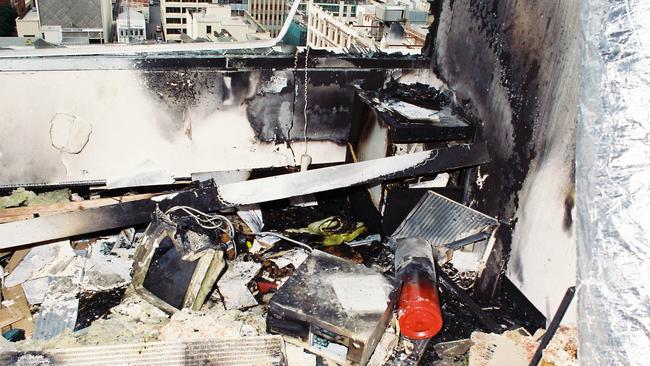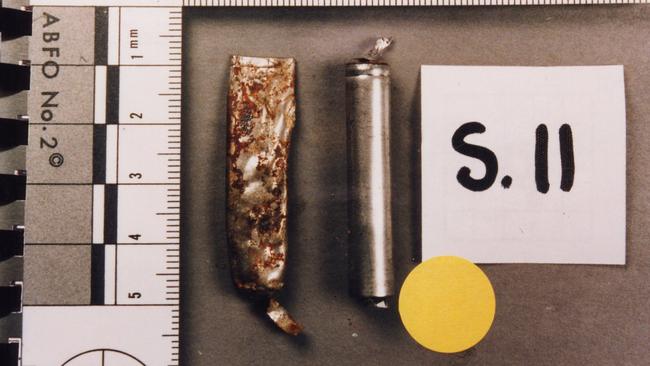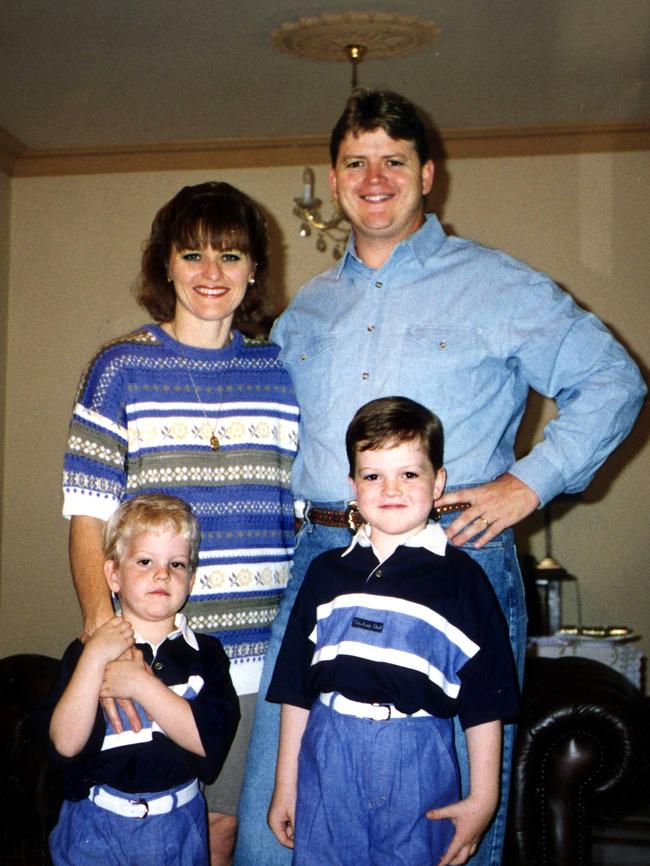Major Crime detectives identify three new suspects in NCA bombing murder of police officer Geoffrey Bowen
EXCLUSIVE: The major police breakthroughs in the NCA bombing case include the identification of two men and a woman as suspects, The Advertiser can reveal.
SA News
Don't miss out on the headlines from SA News. Followed categories will be added to My News.
- Police audio of NCA bombing released for first time
- Mystery caller holds key to fatal 1994 NCA blast
- Widow of Geoffrey Bowen demands justice
- Police confident DNA experts will make bombing breakthrough
POLICE have identified two men and a woman who could be charged with serious offences, including murder, following fresh investigations into the 1994 National Crime Authority bombing.
The new suspects have been identified after detectives obtained partial DNA profiles and fingerprints from key exhibits, and new witnesses have provided information on those involved.
Major Crime officer-in-charge Detective Superintendent Des Bray said police are probing the roles of several men and a woman before and after the bombing.
“We have a number of suspects and now believe people had different roles,’’ he said.
Besides the new suspects, several others could also face lesser charges for either withholding or fabricating evidence provided in the initial stages of the investigation.
It has also been revealed that the bomber’s original plan was to send the parcel bomb to the home of Detective Sergeant Geoffrey Bowen, the police officer killed in the March 2, 1994 blast at the CPS building in Waymouth St.

Detectives have uncovered evidence the bomber was ringing families with the surname “Bowen’’ across Australia a month before the bombing.
Witnesses have told detectives the caller was specifically asking questions to determine if Geoffrey Bowen lived there.
Det Sup Bray last night said if the bomb had exploded at Detective Sgt. Bowen’s home, the result could have been “catastrophic’’ for his wife Jane and two young sons, Simon and Matthew.
ANALYSIS: THE LONG ROAD TO JUSTICE
THE SCIENCE: KILLERS UNDER THE MICROSCOPE
“We believe the caller was trying to establish where Geoff Bowen and his family lived,’’ he said.
“We believe originally the bomb was destined for his home, but then was sent to his work.
“It would have been catastrophic if it was opened with his family sitting around the table.’’
Detective Supt. Bray said it was likely other people with the surname Bowen across Australia received a similar call in February, 1994, and urged them to contact police.
“We have already spoken to some, but we are trying to identify how many people may have been contacted,’’ he said.

The developments in the long-running case follow the establishment of Task Force Cornus last September. It has reviewed all evidence in the case and this year moved into the investigation stage.
It has involved a team of 15 detectives and analysts but at times up to 30 detectives, analysts and others at various stages.
The detectives have established the make-up of the bomb, obtained partial DNA profiles on some exhibits and additional fingerprints from others.
Advanced DNA testing on 65 exhibits is now being conducted in the Netherlands — at the same laboratory that provided the DNA breakthrough in the Louise Bell murder case.
West Australian police officer Detective Sergeant Geoffrey Bowen, 36, was killed in the bombing and lawyer Peter Wallis, 47, was severely injured.
The bomb arrived at the NCA office in the CPS building in an express post pack and was contained in a cardboard post box.
Inside a black plastic zippy bag, the bomb consisted of a nine-volt battery, an incendiary substance, a micro switch, wiring and a small quantity of high explosive.

A week after the blast, Salisbury North man Domenic Perre was arrested and charged with murder and attempted murder.
Perre was committed for trial, but in late 1994 then Director of Public Prosecutions Paul Rofe, QC, withdrew the charges because he did not feel there was enough evidence to secure a conviction.
In 1999 a Coronial Inquest before then Coroner Wayne Chivell delivered damning findings against Perre after a marathon 42-day inquest that heard evidence from 50 witnesses.
In his findings, Mr Chivell stated he believed Perre constructed the bomb, and either posted it or arranged for someone else to post it to Detective Sergeant Bowen.

Detective Supt. Bray confirmed Perre was still a suspect and that detectives were expecting to take a fresh DNA swab and fresh fingerprints from him and the new suspects as the inquiry progressed.
While he would not comment on the identity of the other suspects, it is known they are closely associated with Perre and investigations have been conducted interstate.
“It is not confined to the Perre family,’’ Detective Supt. Bray said.
“We are investigating the roles of several men and a woman before and after the bombing.
“We have a number of suspects and now believe people had different roles.’’
He said the motive for the bombing was clear in that it was intended to kill Detective Sergeant Bowen “with a reckless disregard for anyone else who would be killed or injured in the explosion.’’
“The bomber did not care that if he sent it home it would have killed his wife and children and he did not care if it killed Geoff’s colleagues or even people walking past in the street if they got killed by debris.’’


Detective Supt. Bray said identifying the precise components of the bomb and the type of explosive compound used was a significant development and had provided many additional lines of inquiry for detectives.
“Someone has made it, someone has found out how to make it, someone has sourced the components from others and someone has tested it,’’ he said.
“Knowing that gives us opportunities. People may have assisted with the making of the device in some way without realising what it was going to be used for or they may have just made one component and handed it on.’’
He said it was “significant that some care was taken’’ to ensure the bomb could be sent through the post without detonating and this was a focus of the inquiry.
The fresh investigations have discovered the parcel bomb was tested prior to being perfected, but searches of several locations have proved unsuccessful.
“We have had a look at several places as the test sites, but the passage of time has made it very difficult,’’ Detective Supt. Bray said.

He appealed for anyone who had knowledge of such sites to contact police.
In May, 2008, the reward for information leading to a breakthrough in the case was doubled to $1 million following a major review by now retired detective Chief Superintendent Paul Schramm.
There is also the potential for immunity to be offered to those not directly involved in the murder.
“As well as continuing to investigate who is responsible for this crime, we are focused on identifying witnesses who withheld or fabricated information in the past,’’ Detective Supt. Bray said.
“I would remind them it is not too late for them to come forward.
“I would also say to them that if they are worried about having misled police or have changed their story we can work through those issues if they come forward now and tell the truth.”
Mr Wallis said last night that it was “in the interests of all South Australians the case be solved”.
Anyone calling Crime Stoppers on 1800 333 000 until Thursday morning will be transferred to a Task Force Cornus investigator or they can contact investigators directly by emailing SAPOL.Coldcase@police.sa.gov.au
THE NCA BOMBING
March 2, 1994: Det-Sgt Geoffrey Bowen dies after a parcel bomb he was opening exploded in the authority’s Waymouth St offices.
NCA lawyer Peter Wallis was seriously injured.
March 11, 1994: Police arrest Salisbury East man Domenic Perre and charge him with murder and attempted murder.
August 1994: A magistrate rules Perre’s defence had “put forward some compelling hypotheses consistent with the defendant’s innocence “ but there was evidence “on which the jury might be satisfied beyond reasonable doubt” that he was guilty and he should stand trial.
September 1994: Then Director of Public Prosecutions Paul Rofe announces he has decided to drop the charges because “on all the evidence ... there was not a reasonable prospect of conviction”.
1997: Widow Jane Bowen is awarded a $372,000 ex-gratia payment from the Federal Government.
1999: Then coroner Wayne Chivell completes an inquest into the killing and finds Domenic Perre posted the parcel bomb.
2001: Mr Perre is released after serving a five-year non-parole period of a 9 ½ year sentence for drug offences.
2006: Former workmates of Det-Sgt Bowen hope new DPP Stephen Pallaras, SC, will relaunch the prosecution, but he does not after reviewing the brief.
2007: Cold case review of NCA bombing launched, headed by Detective Chief Superintendent Paul Schramm.
2008: A $1 million reward is posted for information leading to the conviction of the NCA bomber after cold case review fails to result in new charges.
2015: Another review of case, dubbed Taskforcestephen polar Cornus, launched by Major Crime with 30 investigators involved.
2016: In May, detectives reveal vital new information on the case provided by a caller to Crimestoppers.
THE INQUEST EVIDENCE
Evidence that the 1999 inquest found had indicated Domenic Perre’s responsibility for the bombing.
* Perre’s awareness of the prominent role taken by Bowen in the search of his premises on a drug matter in September 1993.
* Perre’s apparent indignation at being arrested in September 1993 on charges relating to the Telecommunications Act after “bugging’’ equipment found during the search of his home.
* Geoffrey Bowen’s provocative behaviour towards Perre at the Adelaide Police Station after the arrest.
* The fact that Perre’s case was listed for trial the day after the bomb exploded.
* Perre’s false statement on March 2, 1994 that he did not know the identity of the person responsible for bringing drug charges against him, when he was clearly aware that it was Geoffrey Bowen.
* The threat to “waste” a senior police officer during the course of a drug production inquiry.
* Perre’s possession of illegal magazines which, when taken in combination, provided sufficient information and instruction on how to build the type of bomb.
* Evidence that Perre hid his weapons collection for safe-keeping.
* Perre’s admissions to witness Allan Chamberlain about the manufacture and testing of bombs.
* The identification of Perre by staff of Dick Smith Electronics as a regular customer who made inquires on one occasion about Zippy boxes and micro-switches, allegedly used in the manufacture of the bomb.



